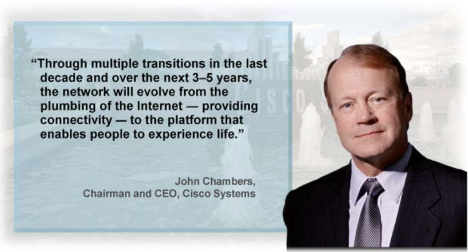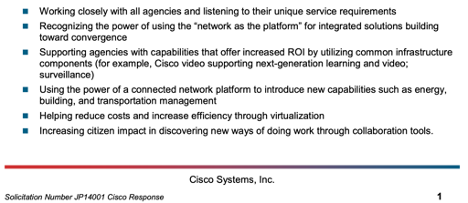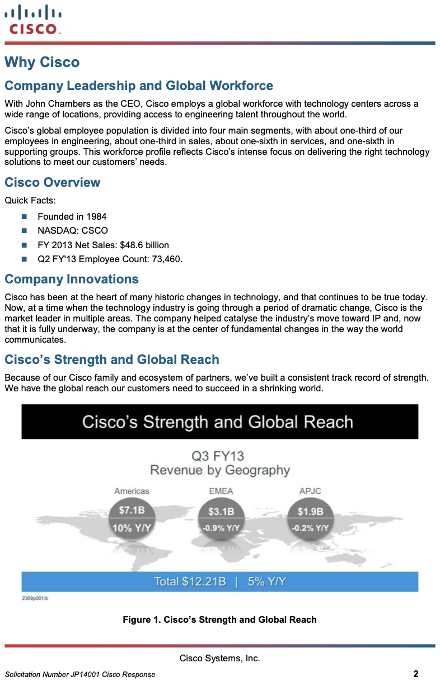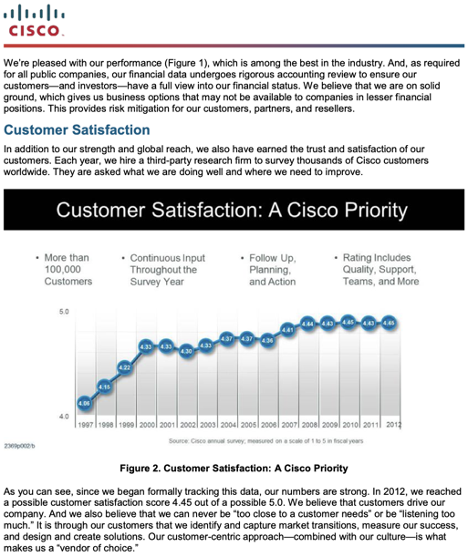5 Winning RFP Responses and Why They Worked: Part One

As an AEC professional, you want to know how to create winning proposals every time. Therefore, you commonly find yourself searching the internet for “successful RFP responses” and “winning proposal examples.” However, it can be stressful or overwhelming to search for reliable information.
Fortunately, this article brings you one step closer to creating compelling RFP responses and winning more business. In this blog, we’ll provide real-life examples of successful RFP responses that you can use to benchmark your next proposal.
Winning RFP Response Example: Cisco
On average, organizations submit 162 RFPs annually. Be it the steel frame of a skyscraper or a convention center, if you’re an AEC professional, then you are likely to encounter a Request for Proposal (RFP) at some time in your career.
If you’re like the proposal writers at Cisco – one of the largest IT companies in the world with $49 billion in revenue and nearly 80,000 employees – then you’re likely one of the best proposal writers in any industry.
The example of a Response to Request for Proposal from Cisco Systems Inc., to the State of Utah Division of Purchasing and General Services, is noteworthy for its cover letter, executive summary, and masterful use of its content, design elements, and digital assets that:
- Showcase Cisco’s phenomenal portfolio,
- Build confidence in the prospective customer,
- Articulate KPIs and success metrics,
- Set the RFP Response apart with context and clarity.
So, what else did Cisco do right? Let’s take a look.
Tailor the Entire Proposal to Cater to the Client’s Needs
Cisco’s proposal is significant because it is tailored to a specific buyer persona (in this case, the State of Utah Division of Purchasing and General Services) and includes added solutions that address that customer’s unique challenges, as shown in the following excerpt from the cover letter.
“Cisco is proud of its partnership with WSCA and the Participating States under our current WSCA Data Communications AR-233 contract since 2007. This rich experience has allowed us to fully understand and appreciate the WSCA-NASPO requirements under this RFP from both the OEM and end-user perspectives.”
By tailoring the proposal to the needs of the client, the proposal writers have made a direct connection between the proposed solution, the various parts of the project understanding, and the requirements laid out in the RFP.
“Cisco has successfully demonstrated that it is a trusted and reliable vendor and partner. We are tremendously proud of the impacts that we have made in helping our WSCA-NASPO government customers serve, protect, and improve the lives of its citizens and communities.”
It does this by creating a narrative that enables the prospective client to visualize their success as a result of the partnership. The seed of this narrative is planted in the cover letter and grows as the prospective client moves to the next section in the proposal, the executive summary.
Combine Substance with a Simple Structure
Cisco’s cover letter and executive summary are noteworthy because they are not only tailored to the needs of the specific client but also utilize a simple structure. They also explain how their solution will not only accomplish the goals of the project but also exceed even the loftiest of client aspirations.

The rest of Cisco’s proposal utilizes the executive summary as a jumping-off point to explain how their solution will be the best choice. The following is an excerpt from Cisco’s executive summary. It’s noteworthy because it errs on the side of brevity and responsiveness.
“Through market leadership, financial strength, and responsible business practices, we demonstrate our enduring capacity to serve the Public Sector as a key partner. We are helping cities, states, and nations manage through the major transitions that we are now facing together. This initiative will help our Public Sector organizations be more relevant to their constituents, enabling them to carry out their mission with a heightened effectiveness.”
Cisco’s executive summary is also significant because it positions the company as a problem solver that offers multiple benefits and value.
“For the Public Sector, we build on many years of understanding agency challenges and opportunities, and we respond by designing comprehensive solutions that address these issues. What does it mean to be a “Trusted Advisor” for the Public Sector?”
The executive summary then proceeds to list the supplemental strategies needed to exceed the goals of the project, as shown in the excerpt below:

The rest of the RFP structure is in the same format and reiterates the bullet points of the executive summary, only in greater detail.
Share Other Projects and Case Studies
Cisco’s proposal writers also do a masterful job of sharing other projects and case studies without oversaturating the client with needless information. As shown in the following screenshot, prudent information is readily provided at the top of the page and quickly summarized with a snappy graphic at the bottom.

Set Your RFP Response Apart With Context and Clarity
Though Cisco’s proposal writers do a phenomenal job of sharing the company’s accolades and showcasing its success, what they are really doing is providing the reader with context, clarity, and a way to compare Cisco’s work to that of the competition.

In other words, Cisco proposal writers include case studies, portfolio examples, survey results and relevant research in their RFP response to prove with verifiable facts and figures that Cisco truly is the best vendor for the project.
Respond to Every Requirement
Though it seems simple, responding to every requirement outlined in the RFP is critical to the success of any proposal. It’s so important, in fact, that Cisco’s proposal writers address the concern in the cover letter.
“We believe that our response meets the requirements as called out in this State of Utah/WSCA-NASPO Solicitation JP14001, except as annotated in our response. If the State of Utah or WSCA-NASPO determines that Cisco’s response is deficient in any way, Cisco respectfully requests to be promptly notified and be given the opportunity to correct any such deficiency.”
They also include the section “Cisco’s Response to Point-by-Point Requirements” to ensure that, indeed, every requirement has been addressed in the body of the proposal.

Create Winning Proposals With OpenAsset
We hope the insights provided in this article gave you the helpful information you need to respond to RFPs successfully like the pros at Cisco.
However, even if you have the right information, you still need the right tools. Without a robust Digital Asset Management (DAM) tool like OpenAsset, crafting a winning RFP proposal is not only difficult, it’s far more unlikely.
To create better proposals and win more business, your firm needs a tool that will not only bring order to your disparate digital assets but also enable your team to be more efficient, more productive, and better able to create high-quality proposals that stand out from the competition.
Designed specifically for firms in the built world, OpenAsset makes it easier to share and manage the multitude of digital assets needed to create proposals like the one featured in this blog.
Contact OpenAsset today to schedule a demo of the only martech solution designed specifically for firms in the built world.
The post 5 Winning RFP Responses and Why They Worked: Part One appeared first on OpenAsset.